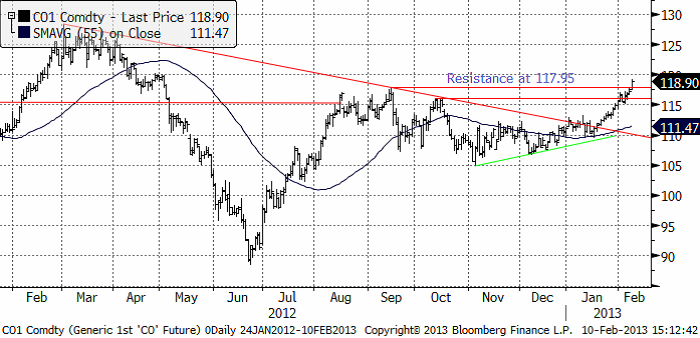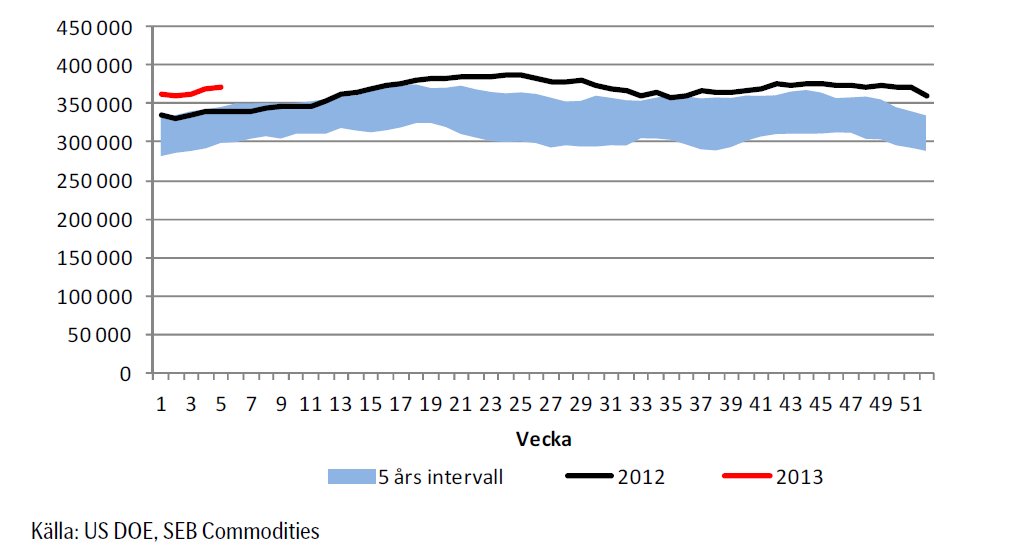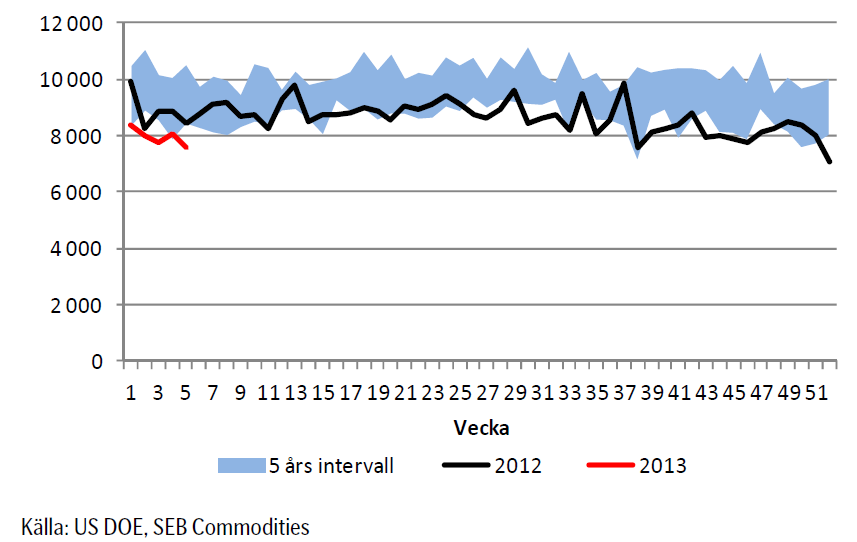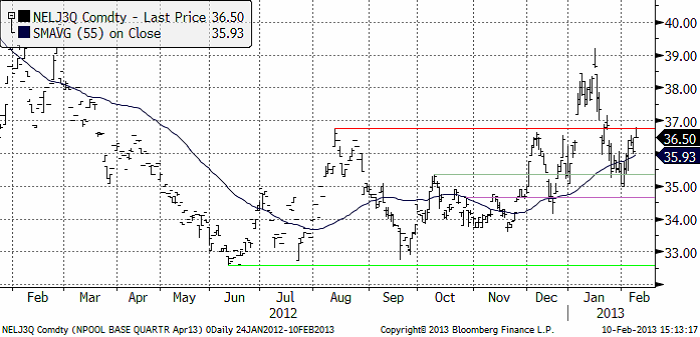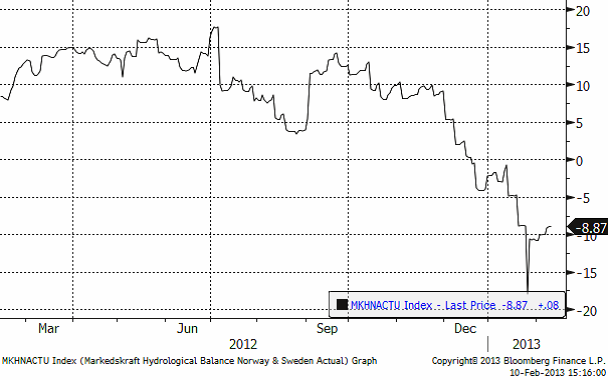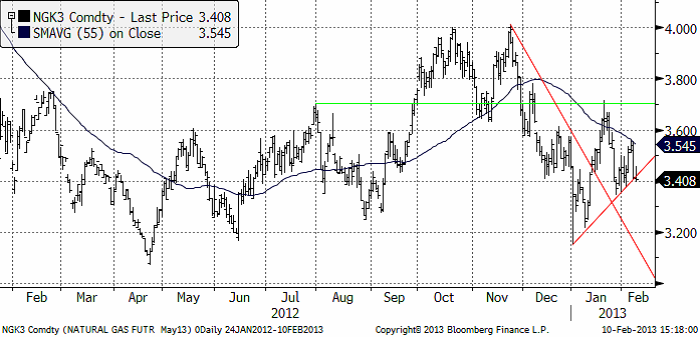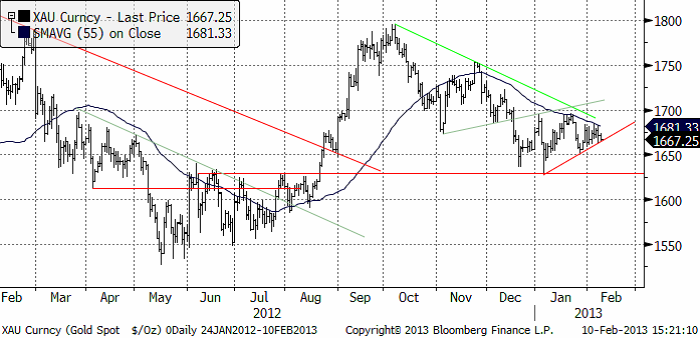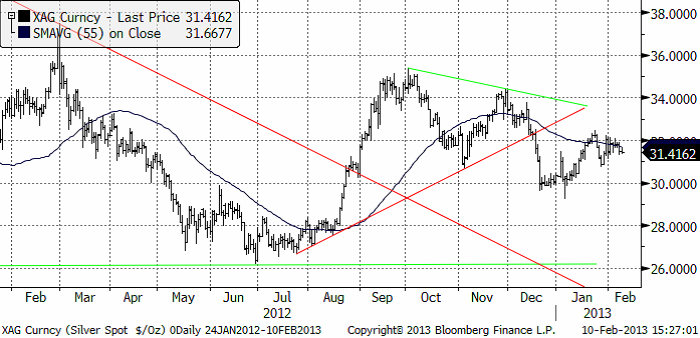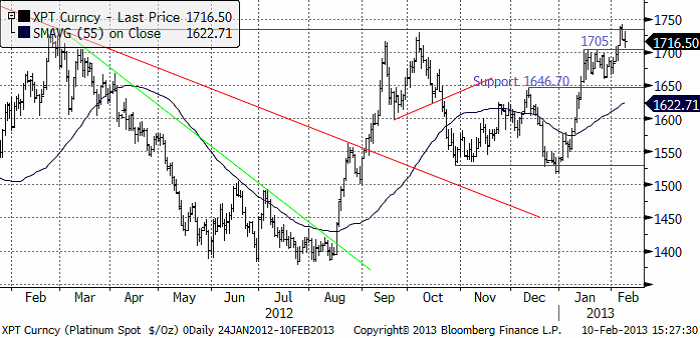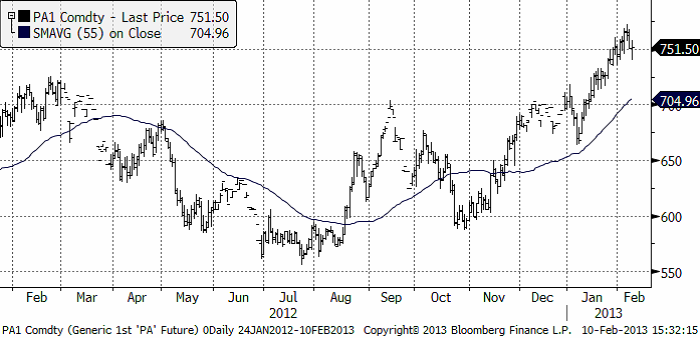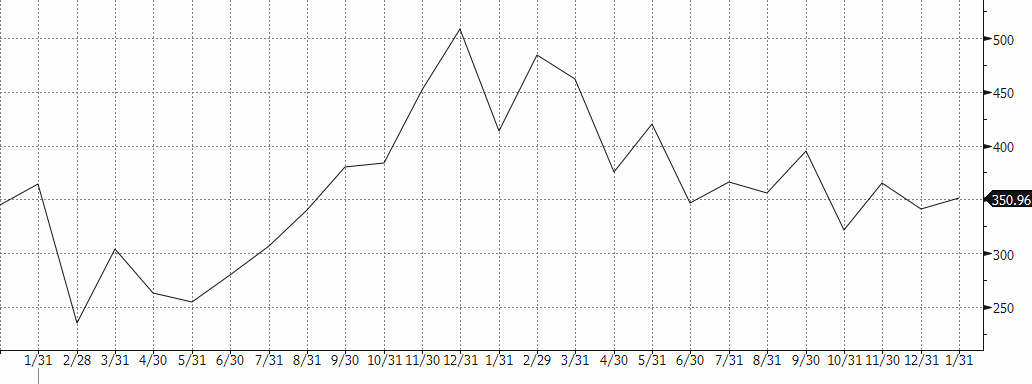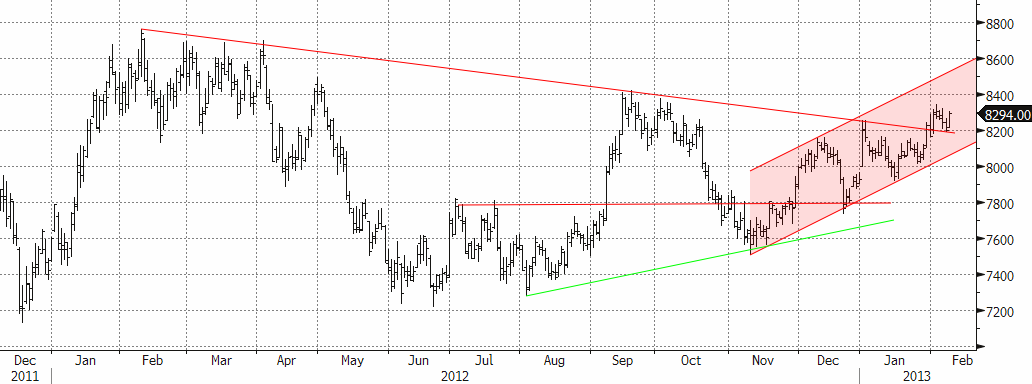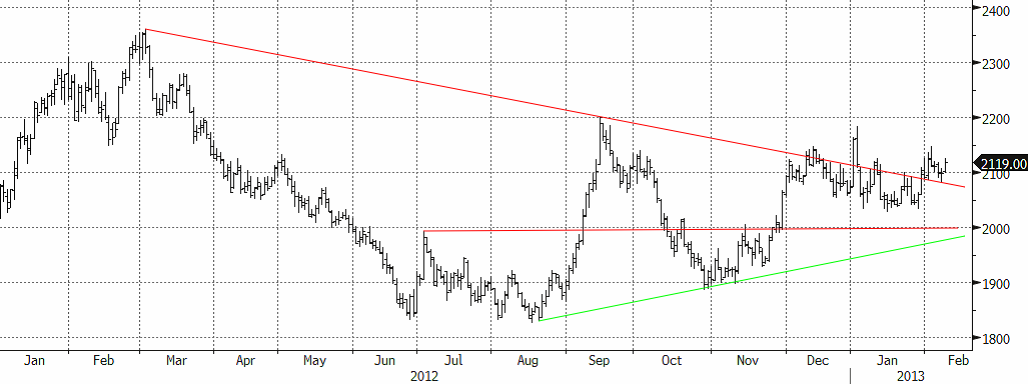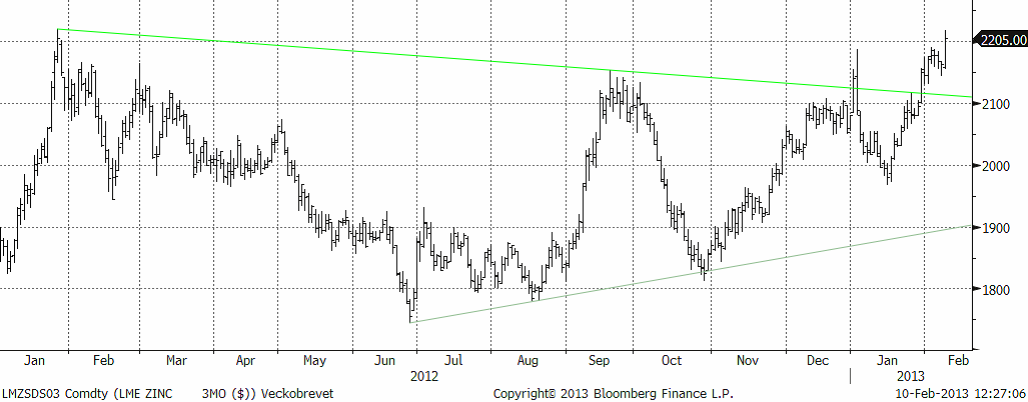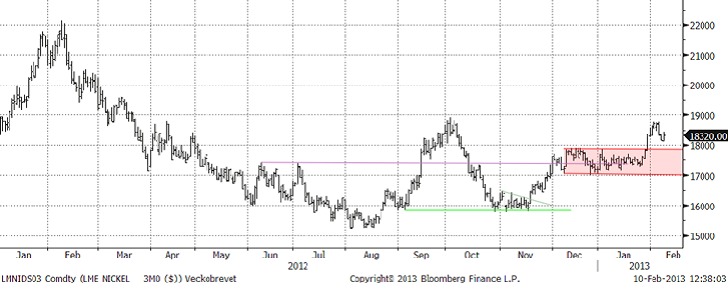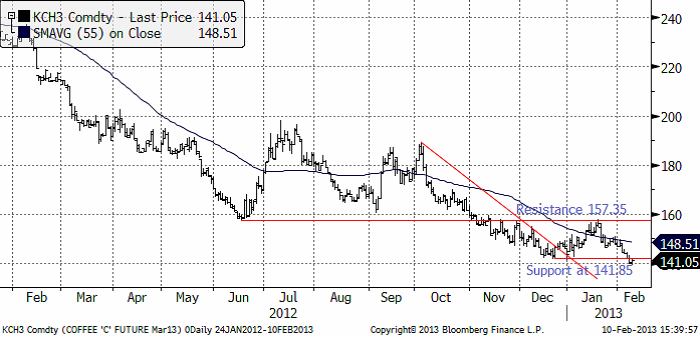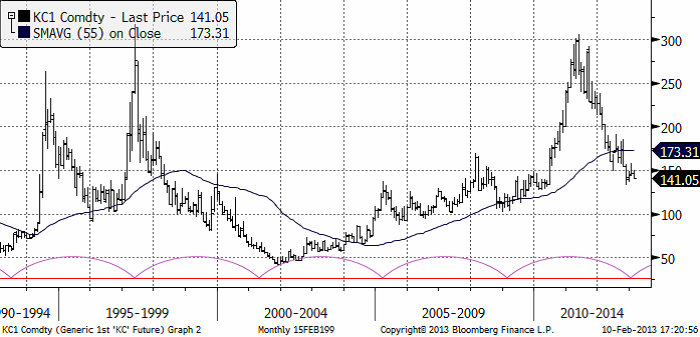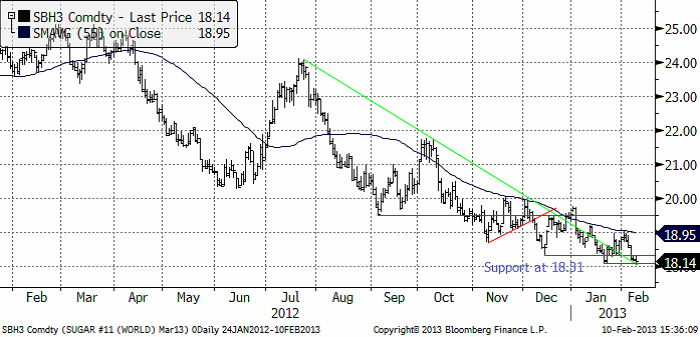Analys
SEB – Råvarukommentarer, 11 februari 2013

Rekommendationer
Inledning
Råvaruindex i svenska kronor steg med 2%, vilket medförde att råvaruindex-certifikatet RAVAROR S steg lika mycket. Aktiemarknaden hade däremot en blandad vecka, där i synnerhet råvarubolaget SSAB:s rapport fick aktien på fall. Råvaror och aktier är inte samma sak, som bekant.
Oljepriset fortsatte att stiga med stöd av tecken på en starkare konjunktur i kombination med att produktionen kortsiktigt stryps av Saudiarabien och på grund av hoten om våld även i Algeriet och Libyen.
Som väntat steg elpriset på Nordpool, vilket fick BULL EL X4 S att stiga med 9% på en vecka. Vi tror att det kan komma en rekyl nedåt, men i ett större perspektiv verkar det som om elpriserna håller på att förbereda sig för en fas av prisuppgång. Såväl marknaden för kol, som utsläppsrätter stärktes i veckan som gick; under stöd av starkare global konjunktur.
I fredags publicerade USDA sina månadsvisa estimat (gissningar) om produktion, konsumtion och utgående lager för vete, majs och sojabönor, bland annat. Det var något av en icke-händelse med endast marginella förändringar i siffrorna.
Kaffepriset föll i veckan, men orosmolnen hopar sig för produktionen i Mellanamerika. I International Coffee Organisations senaste månadsrapport lyfts svampsjukdomarna fram som mycket värre än vad marknaden hittills uppfattat. Samma svampangrepp fick för hundra år sedan ön Ceylon att byta från kaffe till te.
Råolja – Brent
Råoljepriset har brutit alla närliggande tekniska motstånd och har fritt upp till 125 dollar. Vi fortsätter att rekommendera köp av olja. Bäst är om man kan komma in lite billigare efter en rekyl.
Lagren och lagerförändringarna i USA per för den senaste avrapporterade veckan, enligt Department of Energy och American Petroleum Institute visas nedan.
Lagren för destillat och heating oil, som redan låg under förra årets nivå, forsätter att minska. Detta är stödjande.
Råoljelagren fortsatte att byggas på. Nedan ser vi amerikanska råoljelager enligt DOE i tusen fat. Den svarta kurvan är 2012 års lagernivåer vecka för vecka och den lilla röda linjen är 2013 års nivå. Vi ser att lagernivåerna fortsätter att vara högre än de varit sedan 2007 för den här tiden på året.
Lagren ökar samtidigt som vi ser att importen av råolja till USA fortsätter att minska. Man kan ana att konjunktur och den nya ”fracking” tekniken ligger bakom.
Sammanfattningsvis: Köprekommendationen forsätter.
Elektricitet
Elpriset steg snabbt i veckan och stötte på motstånd där det fanns ett i väntan sedan tidigare. Det kan komma en rekyl nedåt. Vi tror att det i så fall är ett köptillfälle. Vi håller fast vid vår rekommendation att köpa EL S eller någon av BULL EL X2 S och BULL EL X4 S, för dem som är villiga att ta mer risk. Prisuppgången i veckan för BULL EL X4 S var hela 9%. Elpriset har kommit ner så pass, till 35 euro per ton, att de kan vara en god idé att försöka köpa BULL EL X2 eller X4 S på de här nivåerna.
Elpriset i Tyskland (den blåa linjen nedan) gjorde verkar ha stabiliserat sig i veckan som gick, som vi ser i diagrammet nedan.
Den hydrologiska balansen för NordPools börsområde gick i veckan från ett underskott på 10 TWh till ett underskott på -8.87 TWh. Det är ”bullish”.
Sammanfattningsvis. Vi tror att det finns goda möjligheter för ytterligare prisuppgång, eventuellt efter en liten rekyl, och rekommenderar en köpt position i el.
Naturgas
Naturgasterminen på NYMEX (mars 2013) gick först upp i början av förra veckan, och föll sedan tillbaka ner. Veckans uppgång nådde inte lika långt som uppgången innan. Det är ett svaghetstecken. Den uppåtgående stödlinjen bröts sedan i fredags. Det är bara precis ett brott, och kanske inte ska säljas på rakt av. Men skulle priset falla under 3.40 i början av veckan som nu börjar, får vi nog tolka det som en kortsiktig säljsignal från den tekniska analysen.
Guld och Silver
Guldpriset orkade som väntat inte ta sig över föregående topp. Mot slutet av veckan vände priset ner igen. Fredagens handel stannade precis på det kortsiktiga stödet, som vi ser i diagrammet nedan. Får vi ett brott nedåt i veckan som kommer så ger det en förnyad säljsignal.
Vi noterar också att guldmarknaden forsätter att bilda ”trianglar” i sin pendling uppåt och nedåt. Det innebär att ett brott uppåt omedelbart genererar en köpsignal. Skulle priset med andra ord gå upp till över 1700 dollar, har vi en köpsignal. Just nu är dock den senaste signalen en säljsignal. Med reservation för att det kan bli en snabb rekommendationsförändring, håller vi fortfarande fast vid den säljrekommendation vi haft sedan december.
Nedan ser vi kursdiagrammet för silver i dollar per troy ounce. Situationen är snarlik den för guld. Rekyl ner till 30 dollar är att vänta. Kortsiktig BEAR-rekommendation för silver också.
Platina & Palladium
Platina bröt uppåt efter en tids konsolidering. Priset gick upp till motståndet på 1734 dollar och stötte i där, som du kunde läsa förra veckan. Nu är 1705 dollar ett tekniskt stöd. Det här är ett spännande läge, för att konsolideringen mellan 1650 och 1705 kan betraktas som en ”flagga” på vägen upp. Dessa brukar dyka upp halvvägs upp i en uppgångsfas. Därmed skulle priset kunna gå upp till 1850. Det som behövs är att motståndet på 1734 dollar definitivt bryts. Vi fortsätter att rekommendera köp av Plantina, t ex med PLATINA S eller BULL PLATIN X4 S.
Palladium fortsatte stiga i början på förra veckan, men föll sedan tillbaka på vinsthemtagningar. Det ser ut som om uppgångsfasen från 700 dollar till 750 kan tänkas behöva en konsolidering vid dessa nya nivåer, innan priset kan fortsätta upp. Men trenden är definitivt uppåtriktad och rekyler bör hellre betraktas som köptillfällen, än som en orsak att lämna marknaden.
Vi rekommenderar en köpt position i palladium, t ex med certifikatet PALLADIUM S eller med BULL PALLAD X4 S, för den som önskar ta mer risk.
Basmetaller
Efter summering av veckans stängningspriser ser det inte ut att ha hänt så mycket. Metallerna är i de flesta fall i princip oförändrade från måndag morgon till fredag kväll. Rörelserna har ändå varit stora däremellan. Vi varnade för en rekyl efter den starka uppgången veckan dessförinnan. Det var just det som skedde. Börser och råvaror fick sig en törn inledningsvis, ökad Europaoro får väl tillskrivas den huvudsakliga orsaken. Men ibland behövs också korrigeringar för att ge ny kraft.
Priserna föll 2-3 % för att under torsdagen och fredagen återhämta, och således stänga oförändrade. Undantaget är favoriten zink som trots en rejäl rekyl stänger upp 1,6 %. Marknaden fick en extra impuls av fredagens handelssiffror från Kina som visade en 25 % -ig ökning av exporten i januari. Importsiffrorna var också starka med en ökning med 28 %, det senare och beror säkert på att ”bokningar” gjorts före det kinesiska nyårsfirandet nästa vecka. Med många kinesiska aktörer på ledighet nästa vecka förväntas volymerna vara begränsade, vilket i sig kan skapa lite oförutsedda prisrörelser. Men troligast är avvaktande handel.
Koppar
Kinas importsiffror för koppar kom in på 350 958 ton, + 2,9 % i januari jämfört med december. Jämfört med januari förra året föll importen med 15,2 % (se månadsstatistiken nedan). Trenden är fallande under året. Möjligtvis anas en tendens till ”urbottning”. Det blir också intressant hur den utvecklas framöver, efter det kinesiska nyåret. Förra året tog det fart under våren.
Kinas kopparimport (1000-tals ton)
Tekniskt sett ser det relativt positivt ut. Efter brottet ur den stora ”triangelformationen”, rekylerade marknaden ned i veckan. Intressant att notera är ”utbrottsnivån” testades och det vände upp exakt på linjen (se nedan). Det brukar vara ett positivt tecken. Om priset lyckas ta sig över toppen för 2 veckor sen kring $8350, öppnas det upp för en uppgång i trendkanalen upp mot nivåer kring $8600.
Som vi skrivit tidigare tyder mycket på ökat utbud för koppar, vilket ökar risken för en lite trögare marknad. Vi ser inte den stora potentialen på koppar på uppsidan just nu. Vi rekommenderar därför en fortsatt neutral position i koppar.
Aluminium
Tekniskt sett liknar bilden den för koppar. ”Utbrottspunkten” tangerades exakt. Om förra veckans topp på $2150 passeras öppnar det upp för ytterligare uppgång. Som vi tidigare skrivit begränsar det överhängande lagret möjligheterna för stora uppgångar. Vi rekommenderar därför fortsättningsvis en neutral position i aluminium.
Zink
Vi varnade för en rekyl, och den kom, men kanske inte så omfattande som väntat. Den stoppade vid $2150. Om vi jämför den tekniska bilden med koppar och aluminium, så kom aldrig priset ned till utbrottspunkten, och det är ett styrketecken. Tekniskt sett får vi en mycket stark stängning som talar för fortsatt uppgång. Vi kvarstår med vår bedömning att marknaden håller på att ”omvärdera” zinken på förväntan om att den fundamentala balansen håller på att svänga om (från stora överskott till mer balanserat). Den ökande produktionen i Kina förra året har väntats minska under Q1. Den senaste statistiken gällande Kinas gruvproduktion visar en fortsatt ökning, vilket riskerar att försena scenariot något.
Vi rekommenderar köp av ZINK S eller BULL ZINK X2 / X4 S för den som vill ta mer risk. Efter de senaste veckornas kraftiga uppgång finns fortfarande risk för en rekyl. För nya köp bör man avvakta en eventuell rekyl ned mot intervallet $2000-$2100.
För den som köpt bör man avvakta veckans inledning för att se om marknaden orkar igenom toppen från januari 2011 på $2020 (i fredags handlades $2018 som högst!). På lite längre sikt är potentialen stor med målet $2400 på 1-2 månaders sikt.
Nickel
Rekylen blev relativt kraftig för nickel, med ett fall från $18760 ned till $18150 som lägst. Priset återhämtade sig, men inte riktigt som övriga metaller. Marknaden är fortsatt tveksam till den fundamentala situationen. Kommentarer från den fysiska marknaden indikerar att ”det finns gott om nickel”, samtidigt som rapporter gör gällande att exporten av nickelmalm från Indonesien till Kina ökar igen, vilket riskerar att öka utbudet av s.k. Nickel Pig Iron i Kina (vilket i sin tur minskar efterfrågan på nickelbärande skrot och primärnickel). Som vi tidigare skrivit kan dock nickel erfarenhetsmässigt ofta överraska. Den tekniska bilden är väldigt tydlig med nästa motståndsnivå vid $19000 och därefter $22000. För den som följde rådet att ta hem vinst i början av veckan, kan det vara värt att gå in igen kring ”utbrottspunkten” $18000 med ett nytt köp.
Vi rekommenderar köp av NICKEL S eller BULL NICKEL X2 / X4 S för den som vill ta mer risk. Efter de senaste veckornas kraftiga uppgång finns risk för en rekyl. För nya köp bör man avvakta en eventuell rekyl ned mot ”utbrottsnivån” $18000. För den som köpt tidigare bör man kortsiktigt ta hem vinst vid motståndsnivån $19000. På lite längre sikt är potentialen större med målet $22 000 på 1-2 månaders sikt.
Kaffe
Kaffepriset föll oväntat i veckan som och studsade på 140 cent per pund. ”Stödet” på 141.85 fungerar nu som motstånd. Vi tror trots allt att marknaden befinner sig i en vändningsfas efter två års kraftigt prisfall. Den jämna prisnivån 140 cent fungerar också som ett stöd i sig. Det finns säkerligen en hel del köpordrar lagda på den nivån. Men vi skulle vilja se priset stiga över stödnivån på 141.85 cent för att förtroendet för att vändningsfasen ska ske på den här nivån ska stärkas.
Det har kommit ännu mer information som borde ge stöd för marknaden. International Coffee Organisation (”ICO”) publicerade den senaste månadsrapporten i torsdags. Där står att marknaden just nu tyngs av stora säljintressen i robusta. Om krisen i Mellanamerika, som vi tidigare rapporterat om står:
”In Central America, outbreaks of coffee leaf rust have now been reported in all major coffeeproducing countries. Authorities in Costa Rica have declared a state of emergency in order to tackle the spread of the fungus. In Guatemala and El Salvador, there are reports that rust could have affected 40_50% of all coffee plants, with both countries enacting programmes to provide fungicide to coffee farmers. Nicaragua has also recently launched a campaign to train experts and growers against the spread, while Honduras has declared a phytosanitary emergency. Coffee leaf rust has also been reported in certain parts of Mexico. This outbreak could have serious long_term implications for the production of Washed Arabicas in Central America, with the region potentially losing around 2.5 to 3 million bags of coffee.”
I diagrammet nedan ser vi lite längre prishistorik på kaffe. I den nedre delen av diagrammet ser vi en priscykel om lite drygt fyra år. Den verkar finnas där (statistiskt säkerställd). Kanske har den sitt ursprung i vartannatårs-karaktären av skördens storlek från arabica-busken, i kombination med hur lantbrukarna reagerar på den och prisförändringarna. Enligt den här pris-cykeln, är priset nära en cyklisk botten nu.
Vi fortsätter att rekommendera köp av KAFFE S eller BULL KAFFE X4 S för den som vill ta mer risk.
Socker
Sockerpriset (mars 2013) föll kraftigt i början av veckan. Den förra botten från januari på 18 cent, fungerade nu som ett stöd. I fredags stängde mars-kontraktet på 18.14 cent per pund. Det är strax över stödet på 18 cent. Trenden är nedåtriktad och kraften av den rörelsen ”bör” enligt beprövad erfarenhet få stödet att brytas, kanske redan i veckan.
Vi fortsätter med neutral rekommendation på socker, i avvaktan på mer tecken på att prisfallet är över.
[box]SEB Veckobrev Veckans råvarukommentar är producerat av SEB Merchant Banking och publiceras i samarbete och med tillstånd på Råvarumarknaden.se[/box]
Disclaimer
The information in this document has been compiled by SEB Merchant Banking, a division within Skandinaviska Enskilda Banken AB (publ) (“SEB”).
Opinions contained in this report represent the bank’s present opinion only and are subject to change without notice. All information contained in this report has been compiled in good faith from sources believed to be reliable. However, no representation or warranty, expressed or implied, is made with respect to the completeness or accuracy of its contents and the information is not to be relied upon as authoritative. Anyone considering taking actions based upon the content of this document is urged to base his or her investment decisions upon such investigations as he or she deems necessary. This document is being provided as information only, and no specific actions are being solicited as a result of it; to the extent permitted by law, no liability whatsoever is accepted for any direct or consequential loss arising from use of this document or its contents.
About SEB
SEB is a public company incorporated in Stockholm, Sweden, with limited liability. It is a participant at major Nordic and other European Regulated Markets and Multilateral Trading Facilities (as well as some non-European equivalent markets) for trading in financial instruments, such as markets operated by NASDAQ OMX, NYSE Euronext, London Stock Exchange, Deutsche Börse, Swiss Exchanges, Turquoise and Chi-X. SEB is authorized and regulated by Finansinspektionen in Sweden; it is authorized and subject to limited regulation by the Financial Services Authority for the conduct of designated investment business in the UK, and is subject to the provisions of relevant regulators in all other jurisdictions where SEB conducts operations. SEB Merchant Banking. All rights reserved.
Analys
OPEC+ will likely unwind 500 kb/d of voluntary quotas in October. But a full unwind of 1.5 mb/d in one go could be in the cards

Down to mid-60ies as Iraq lifts production while Saudi may be tired of voluntary cut frugality. The Brent December contract dropped 1.6% yesterday to USD 66.03/b. This morning it is down another 0.3% to USD 65.8/b. The drop in the price came on the back of the combined news that Iraq has resumed 190 kb/d of production in Kurdistan with exports through Turkey while OPEC+ delegates send signals that the group will unwind the remaining 1.65 mb/d (less the 137 kb/d in October) of voluntary cuts at a pace of 500 kb/d per month pace.

Signals of accelerated unwind and Iraqi increase may be connected. Russia, Kazakhstan and Iraq were main offenders versus the voluntary quotas they had agreed to follow. Russia had a production ’debt’ (cumulative overproduction versus quota) of close to 90 mb in March this year while Kazakhstan had a ’debt’ of about 60 mb and the same for Iraq. This apparently made Saudi Arabia angry this spring. Why should Saudi Arabia hold back if the other voluntary cutters were just freeriding? Thus the sudden rapid unwinding of voluntary cuts. That is at least one angle of explanations for the accelerated unwinding.
If the offenders with production debts then refrained from lifting production as the voluntary cuts were rapidly unwinded, then they could ’pay back’ their ’debts’ as they would under-produce versus the new and steadily higher quotas.
Forget about Kazakhstan. Its production was just too far above the quotas with no hope that the country would hold back production due to cross-ownership of oil assets by international oil companies. But Russia and Iraq should be able to do it.
Iraqi cumulative overproduction versus quotas could reach 85-90 mb in October. Iraq has however steadily continued to overproduce by 3-5 mb per month. In July its new and gradually higher quota came close to equal with a cumulative overproduction of only 0.6 mb that month. In August again however its production had an overshoot of 100 kb/d or 3.1 mb for the month. Its cumulative production debt had then risen to close to 80 mb. We don’t know for September yet. But looking at October we now know that its production will likely average close to 4.5 mb/d due to the revival of 190 kb/d of production in Kurdistan. Its quota however will only be 4.24 mb/d. Its overproduction in October will thus likely be around 250 kb/d above its quota with its production debt rising another 7-8 mb to a total of close to 90 mb.
Again, why should Saudi Arabia be frugal while Iraq is freeriding. Better to get rid of the voluntary quotas as quickly as possible and then start all over with clean sheets.
Unwinding the remaining 1.513 mb/d in one go in October? If OPEC+ unwinds the remaining 1.513 mb/d of voluntary cuts in one big go in October, then Iraq’s quota will be around 4.4 mb/d for October versus its likely production of close to 4.5 mb/d for the coming month..
OPEC+ should thus unwind the remaining 1.513 mb/d (1.65 – 0.137 mb/d) in one go for October in order for the quota of Iraq to be able to keep track with Iraq’s actual production increase.
October 5 will show how it plays out. But a quota unwind of at least 500 kb/d for Oct seems likely. An overall increase of at least 500 kb/d in the voluntary quota for October looks likely. But it could be the whole 1.513 mb/d in one go. If the increase in the quota is ’only’ 500 kb/d then Iraqi cumulative production will still rise by 5.7 mb to a total of 85 mb in October.
Iraqi production debt versus quotas will likely rise by 5.7 mb in October if OPEC+ only lifts the overall quota by 500 kb/d in October. Here assuming historical production debt did not rise in September. That Iraq lifts its production by 190 kb/d in October to 4.47 mb/d (August level + 190 kb/d) and that OPEC+ unwinds 500 kb/d of the remining quotas in October when they decide on this on 5 October.

Analys
Modest draws, flat demand, and diesel back in focus

U.S. commercial crude inventories posted a marginal draw last week, falling by 0.6 million barrels to 414.8 million barrels. Inventories remain 4% below the five-year seasonal average, but the draw is far smaller than last week’s massive 9.3-million-barrel decline. Higher crude imports (+803,000 bl d WoW) and steady refinery runs (93% utilization) helped keep the crude balance relatively neutral.

Yet another drawdown indicates commercial crude inventories continue to trend below the 2015–2022 seasonal norm (~440 million barrels), though at 414.8 million barrels, levels are now almost exactly in line with both the 2023 and 2024 trajectory, suggesting stable YoY conditions (see page 3 attached).
Gasoline inventories dropped by 1.1 million barrels and are now 2% below the five-year average. The decline was broad-based, with both finished gasoline and blending components falling, indicating lower output and resilient end-user demand as we enter the shoulder season post-summer (see page 6 attached).
On the diesel side, distillate inventories declined by 1.7 million barrels, snapping a two-week streak of strong builds. At 125 million barrels, diesel inventories are once again 8% below the five-year average and trending near the low end of the historical range.
In total, commercial petroleum inventories (excl. SPR) slipped by 0.5 million barrels on the week to ish 1,281.5 million barrels. While essentially flat, this ends a two-week streak of meaningful builds, reflecting a return to a slightly tighter situation.
On the demand side, the DOE’s ‘products supplied’ metric (see page 6 attached), a proxy for implied consumption, softened slightly. Total demand for crude oil over the past four weeks averaged 20.5 million barrels per day, up just 0.9% YoY.
Summing up: This week’s report shows a re-tightening in diesel supply and modest draws across the board, while demand growth is beginning to flatten. Inventories remain structurally low, but the tone is less bullish than in recent weeks.
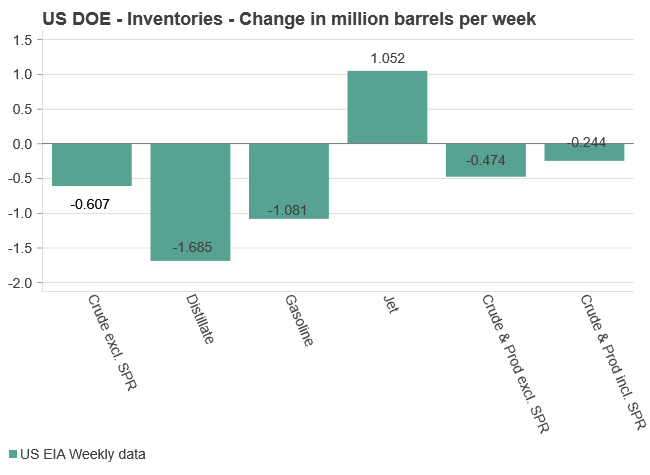
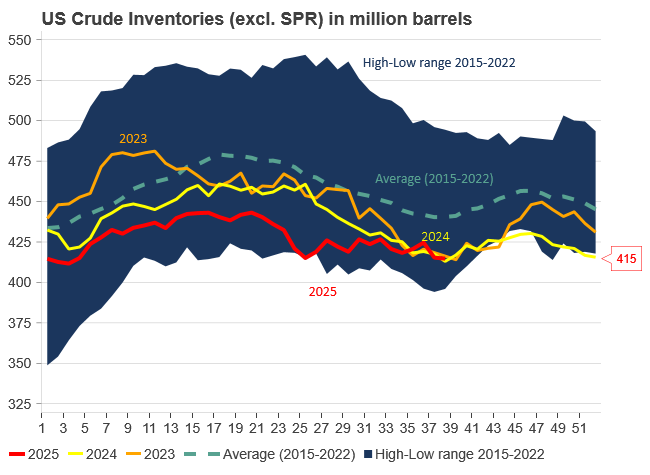
Analys
Are Ukraine’s attacks on Russian energy infrastructure working?

Brent crude rose 1.6% yesterday. After trading in a range of USD 66.1 – 68.09/b it settled at USD 67.63/b. A level which we are well accustomed to see Brent crude flipping around since late August. This morning it is trading 0.5% higher at USD 68/b. The market was expecting an increase of 230 kb/d in Iraqi crude exports from Kurdistan through Turkey to the Cheyhan port but that has so far failed to materialize. This probably helped to drive Brent crude higher yesterday. Indications last evening that US crude oil inventories likely fell 3.8 mb last week (indicative numbers by API) probably also added some strength to Brent crude late in the session. The market continues to await the much heralded global surplus materializing as rising crude and product inventories in OECD countries in general and the US specifically.

The oil market is starting to focus increasingly on the successful Ukrainian attacks on Russian oil infrastructure. Especially the attacks on Russian refineries. Refineries are highly complex and much harder to repair than simple crude oil facilities like export pipelines, ports and hubs. It can take months and months to repair complex refineries. It is thus mainly Russian oil products which will be hurt by this. First oil product exports will go down, thereafter Russia will have to ration oil product consumption domestically. Russian crude exports may not be hurt as much. Its crude exports could actually go up as its capacity to process crude goes down. SEB’s Emerging Market strategist Erik Meyersson wrote about the Ukrainian campaign this morning: ”Are Ukraine’s attacks on Russian energy infrastructure working?”. Phillips P O’Brian published an interesting not on this as well yesterday: ”An Update On The Ukrainian Campaign Against Russian Refineries”. It is a pay-for article, but it is well worth reading. Amongst other things it highlights the strategic focus of Ukraine towards Russia’s energy infrastructure. A Ukrainian on the matter also put out a visual representation of the attacks on twitter. We have not verified the data representation. It needs to be interpreted with caution in terms of magnitude of impact and current outage.
Complex Russian oil refineries are sitting ducks in the new, modern long-range drone war. Ukraine is building a range of new weapons as well according to O’Brian. The problem with attacks on Russian refineries is thus on the rise. This will likely be an escalating problem for Russia. And oil products around the world may rise versus the crude oil price while the crude oil price itself may not rise all that much due to this.
Russian clean oil product exports as presented by SEB’s Erik Meyersson in his note this morning.
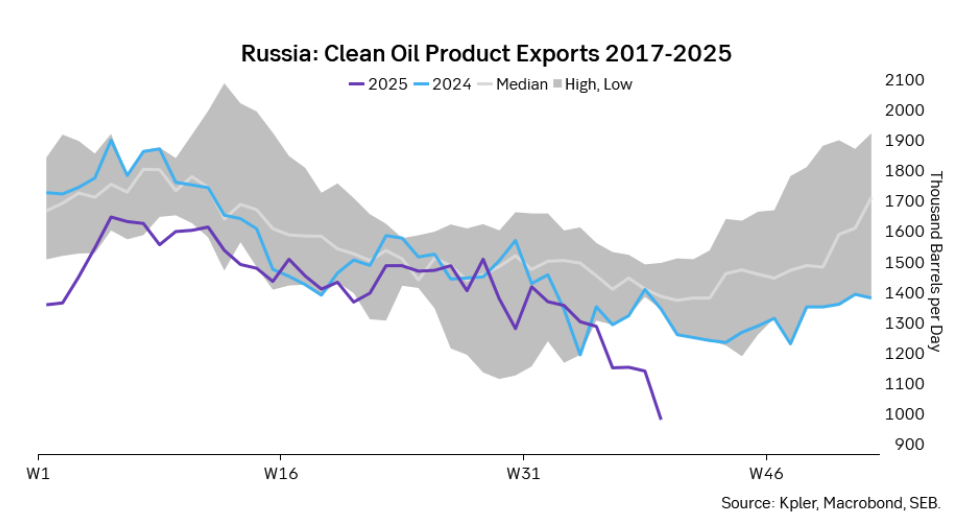
The ICE Gasoil crack and the 3.5% fuel oil crack has been strengthening. The 3.5% crack should have weakened along with rising exports of sour crude from OPEC+, but it hasn’t. Rather it has moved higher instead. The higher cracks could in part be due to the Ukrainian attacks on Russian oil refineries.
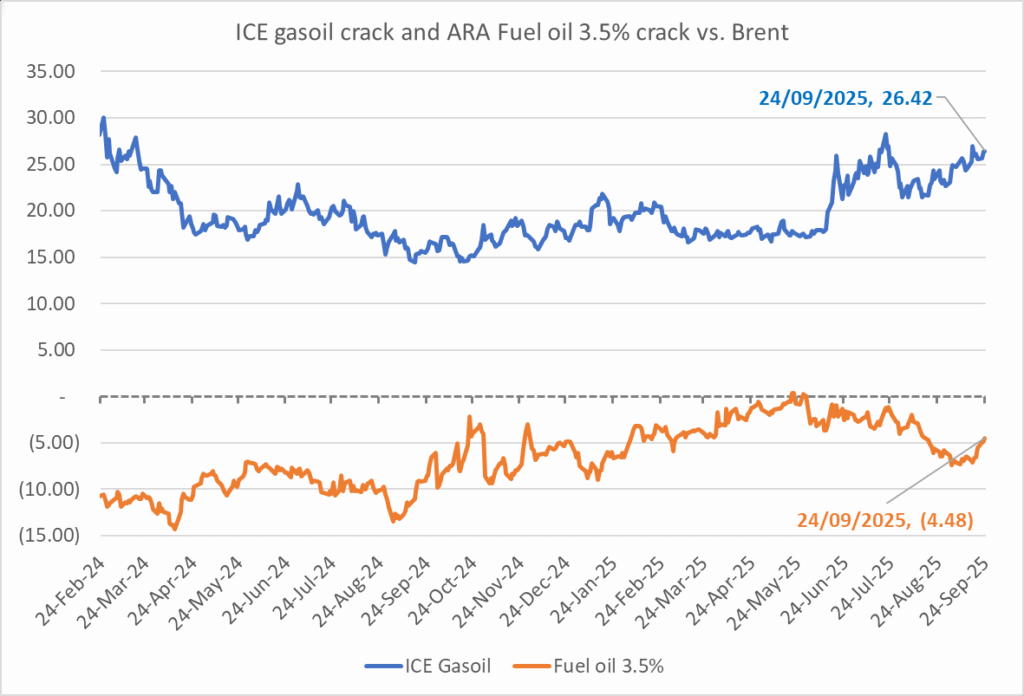
Ukrainian inhabitants graphical representation of Ukrainian attacks on Russian oil refineries on Twitter. Highlighting date of attacks, size of refineries and distance from Ukraine. We have not verified the detailed information. And you cannot derive the amount of outage as a consequence of this.

-

 Nyheter4 veckor sedan
Nyheter4 veckor sedanEurobattery Minerals satsar på kritiska metaller för Europas självförsörjning
-

 Nyheter3 veckor sedan
Nyheter3 veckor sedanMahvie Minerals i en guldtrend
-

 Nyheter4 veckor sedan
Nyheter4 veckor sedanGuldpriset kan närma sig 5000 USD om centralbankens oberoende skadas
-

 Nyheter4 veckor sedan
Nyheter4 veckor sedanOPEC signalerar att de inte bryr sig om oljepriset faller kommande månader
-

 Analys3 veckor sedan
Analys3 veckor sedanVolatile but going nowhere. Brent crude circles USD 66 as market weighs surplus vs risk
-
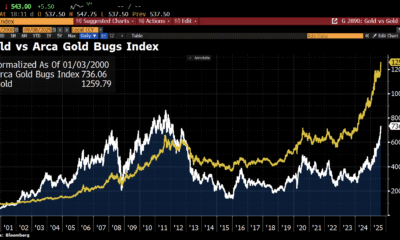
 Nyheter3 veckor sedan
Nyheter3 veckor sedanAktier i guldbolag laggar priset på guld
-

 Nyheter3 veckor sedan
Nyheter3 veckor sedanKinas elproduktion slog nytt rekord i augusti, vilket även kolkraft gjorde
-

 Nyheter2 veckor sedan
Nyheter2 veckor sedanTyskland har så höga elpriser att företag inte har råd att använda elektricitet



